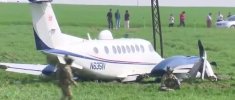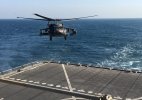-
Please take a moment and update your account profile. If you have an updated account profile with basic information on why you are on Air Warriors it will help other people respond to your posts. How do you update your profile you ask?
Go here:
Edit Account Details and Profile
You are using an out of date browser. It may not display this or other websites correctly.
You should upgrade or use an alternative browser.
You should upgrade or use an alternative browser.
Navy Dedicated SAR Squadrons
- Thread starter Ventus
- Start date
If it’s who I think it is, he’s retiring soon anyway, right?I’ll wait until one of us is off active duty but I am betting it’s exactly who you think it is.
Nice elicitation techniqueIf it’s who I think it is, he’s retiring soon anyway, right?

They were relieved by Army National Guard HH-60Ms from Florida.Not JO's, CENTCOM. The USAF RQS community was maxed out after constant deployments and there was a gap in coverage. Ultimately SECDEF had to step in and order the Navy to do our part and we complied. But you are correct in that the Navy immediately claimed it would never happen again. Not due to Money/Logistics but because "we didn't buy these aircraft to risk losing them over land" (Heard that from 2 separate AIRBOSSes)
CSAR is not Medevac which is not Casevac. They share a lot of overlap, but also a lot of differences. The Air Force has aerial refueling. I'm sure they practice this a lot. The Army has Fat Cow/FARP capability with Chinooks; something practiced frequently as well. The Navy??? Well, they have ships that are VERY useful for coastal operations but useless deep overland.
My opinion is based on deployments in HSL, HS and Army Medevac. In the Navy, we always 'thought' we could do overland missions just as well as anyone else. Then I flew in the Army and learned how much I didn't know that I didn't know. Likewise, in the Army they underestimated the difficulty in shipboard landings and overwater hoist missions. Luckily I had done both in the Navy, but I still found it hard to bring a battalion up to (half) speed at doing these missions. I spent a LOT of my time organizing resources to conduct shipboard and overwater training and convincing higher ups that these resources were necessary. I believe that to be the weakness in the Navy's/HSC's approach to CSAR. Most don't know what they don't know. Those that have an inkling lack the authority or clout to convince their higher ups to commit the time and $$$ to make it happen. In the end, the Florida National Guard's shipboard landing program died because we couldn't convince our higher ups to spend the money to continue sending us to scheduling conferences or flying small DETs to Norfolk for the deck time. For us, the decision was made at the O-7/O-8 level. For Navy CSAR/Casevac, SecDef made the Navy make it happen for CENTCOM in the short term, but couldn't make it stick in the long term.
BTW, did the Navy pickup the C-12 crew up there in 2016? That was in a VERY permissive environment and lends little credibility to CSAR capability claims for whoever did it.

BTW, did the Navy pickup the C-12 crew up there in 2016? That was in a VERY permissive environment and lends little credibility to CSAR capability claims for whoever did it.View attachment 40237
Yes, and I know the crew and many members of the det that were there on alert. I will attest they are excellent pilots and leaders (the ones I've met).
Permissive or not, a neat tidbit in HSC history at a time when people were questioning the value of helos off the carrier that proved worthy.
Weird-ass video from the ground though.Yes, and I know the crew and many members of the det that were there on alert. I will attest they are excellent pilots and leaders (the ones I've met).
Permissive or not, a neat tidbit in HSC history at a time when people were questioning the value of helos off the carrier that proved worthy.
Yes we recovered the C-12 crew in 2016.They were relieved by Army National Guard HH-60Ms from Florida.
CSAR is not Medevac which is not Casevac. They share a lot of overlap, but also a lot of differences. The Air Force has aerial refueling. I'm sure they practice this a lot. The Army has Fat Cow/FARP capability with Chinooks; something practiced frequently as well. The Navy??? Well, they have ships that are VERY useful for coastal operations but useless deep overland.
My opinion is based on deployments in HSL, HS and Army Medevac. In the Navy, we always 'thought' we could do overland missions just as well as anyone else. Then I flew in the Army and learned how much I didn't know that I didn't know. Likewise, in the Army they underestimated the difficulty in shipboard landings and overwater hoist missions. Luckily I had done both in the Navy, but I still found it hard to bring a battalion up to (half) speed at doing these missions. I spent a LOT of my time organizing resources to conduct shipboard and overwater training and convincing higher ups that these resources were necessary. I believe that to be the weakness in the Navy's/HSC's approach to CSAR. Most don't know what they don't know. Those that have an inkling lack the authority or clout to convince their higher ups to commit the time and $$$ to make it happen. In the end, the Florida National Guard's shipboard landing program died because we couldn't convince our higher ups to spend the money to continue sending us to scheduling conferences or flying small DETs to Norfolk for the deck time. For us, the decision was made at the O-7/O-8 level. For Navy CSAR/Casevac, SecDef made the Navy make it happen for CENTCOM in the short term, but couldn't make it stick in the long term.
BTW, did the Navy pickup the C-12 crew up there in 2016? That was in a VERY permissive environment and lends little credibility to CSAR capability claims for whoever did it.View attachment 40237
Not as permissive as the photos make you think, but of course that level of intel never makes it into cell phone pictures and video. Instead, everyone with minimal actual knowledge becomes an armchair expert on internet forums like AW.
Technically our relief was a combination of those Army guys and an Italian CSAR det with four A129 attack helicopters and four NH90s for recovery. But you are correct, in that most of the Navy doesn't know what it doesn't know. Due to the differences and lack of true dedicated training in the Navy, before going truly operational we spent some time doing specialized workups in conjunction with the neighboring RQS squadron, A-10s, and the PJ team that embedded with us.
Huh never saw the ground video. Saw one from the air on SIPR pretty quickly after it came out unless I am misremembering things.Weird-ass video from the ground though.
Gotta get ready for being an attaché somehow!Nice elicitation technique
There’s a school for that…Gotta get ready for being an attaché somehow!

Please just tell us the combat FCF was a tongue-in-cheek evil shenaniganYes we recovered the C-12 crew in 2016.
Not as permissive as the photos make you think, but of course that level of intel never makes it into cell phone pictures and video. Instead, everyone with minimal actual knowledge becomes an armchair expert on internet forums like AW.
Technically our relief was a combination of those Army guys and an Italian CSAR det with four A129 attack helicopters and four NH90s for recovery. But you are correct, in that most of the Navy doesn't know what it doesn't know. Due to the differences and lack of true dedicated training in the Navy, before going truly operational we spent some time doing specialized workups in conjunction with the neighboring RQS squadron, A-10s, and the PJ team that embedded with us.
Please just tell us the combat FCF was a tongue-in-cheek evil shenanigan
Yes and no. I'd have to check my logbook, but I think there were only a few flights out there where we didn't observe some sort of surface to air fire aimed at us. Though it did run the gamut from small arms to lasers to MANPAD indications and most was less than accurate, but it was still there.
We based our classification on the USAF criteria since it was actually written to reflect the risk to each platform type, whereas the Navy instruction is clearly based on jets cruising around at 20k ft and above with no thought to helos down low. We also found out the jet guys in our airwing were doubling up points by counting sorties and individual events to get themselves AMs, so we poked back with the Combat FCF. CAG and the Admiral realized we had a point, so the classification stood.
Would love to hear more about this. Whenever I deployed (09-20 timeframe), a mission over the beach into a combat zone (Iraq, Afg, or Syria) was 1 air medal point. Employing a weapon earned 1 additional point for that mission- even if multiple weapons were employed. Does “doubling up” by “individual events”, above, refer to multiple weapon employments or were some other shenanigans going on?We also found out the jet guys in our airwing were doubling up points by counting sorties and individual events to get themselves AMs, so we poked back with the Combat FCF. CAG and the Admiral realized we had a point, so the classification stood.
While I didn't make it to Erbil, I was the C Co 1-111th (those Army guys) SIP for the deployment in 2016/2017. That is until I got attached to the 77th CAB and occasionally farmed out to ARCENT. I knew Navy and shipboard "stuff." At least I got to keep flying out of Buehring, doing shipboard landing instruction and medevac duty, as well as a bunch of CDAG stuff. I did manage to make a few short trips "up north" during the deployment. Having been in Somalia in 1992 and Iraq in 2011, I wasn't disappointed spending minimal time in Iraq in 2016/2017, especially at my age at the time (53).Yes we recovered the C-12 crew in 2016.
Not as permissive as the photos make you think, but of course that level of intel never makes it into cell phone pictures and video. Instead, everyone with minimal actual knowledge becomes an armchair expert on internet forums like AW.
Technically our relief was a combination of those Army guys and an Italian CSAR det with four A129 attack helicopters and four NH90s for recovery. But you are correct, in that most of the Navy doesn't know what it doesn't know. Due to the differences and lack of true dedicated training in the Navy, before going truly operational we spent some time doing specialized workups in conjunction with the neighboring RQS squadron, A-10s, and the PJ team that embedded with us.

Permissive is relative. If Army medevac is flying and not 160th or AF CSAR, it's permissive. That's where I tend to draw the line. That's not to say I was never shot at doing Army medevac in the "permissive" environment of Iraq or been rocketed and mortared in a "permissive" environment. A burning MRAP was not unusual to see upon landing at the POI. We just never launched where we KNEW we would be flying into or near the engagement zone of really bad stuff. That's something I associate with 160th or AF CSAR. IMO, recovering an aircrew from an aircraft that breaks down is quite different from one that has been shot down.
2016 Deck Landings.

Permissive is relative. If Army medevac is flying and not 160th or AF CSAR, it's permissive. That's where I tend to draw the line. That's not to say I was never shot at doing Army medevac in the "permissive" environment of Iraq or been rocketed and mortared in a "permissive" environment. A burning MRAP was not unusual to see upon landing at the POI. We just never launched where we KNEW we would be flying into or near the engagement zone of really bad stuff. That's something I associate with 160th or AF CSAR. IMO, recovering an aircrew from an aircraft that breaks down is quite different from one that has been shot down.
Buehring was certainly an interesting place. It always gave me a weird vibe that I couldn't really describe, like it was permanently temporary.
During our time in Erbil, Army Medevac (a great group of Arkansas boys) were not allowed to fly outside the wire due to the risk. If I recall correctly their recovery mission to Fire Base Bell after the mortar attack was only the second time they actually got cleared to leave the compound. We always got a good chuckle watching them doing yo-yos inside the limits of the fence line because it was the only way they could get flight hours.

